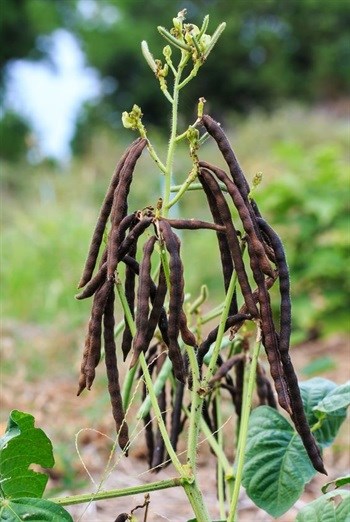With more than one crop, farmers weather armyworm attacks

An infestation of crop-eating caterpillars known as Fall armyworm has ravaged harvests in Kenya and neighbouring countries, exacerbating damage already caused by prolonged drought.
James Ndanda, a government agricultural officer, estimates that about 40 percent of farms in western Kenya have been affected by the pest.
"Farmers will get a poor maize harvest this season," he predicted. "That could lead to food insecurity as the region is a big producer of maize."
Better odds
To protect themselves from total crop failure, Owuoda and over 50 other farmers in Nyatike village grow pulses alongside their traditional crops like maize - a practice known as intercropping.
"I grow green gram with maize so that if one crop fails I can get a harvest from the other," he explained. His three acres of maize are infested with the Fall armyworm, while his one acre of green gram - also known as mung bean - is so far intact.
Other farmers in the village have diversified their production, some by growing soy beans as well as mung bean, and many said they expect to reap at least one harvest despite the drought.
But about 20km (12 miles) from Owuoda's farm, George Onyango is not expecting a good harvest. Almost all of his 10 acres of maize have been destroyed by armyworm. During a good harvest, he can get 200 bags of maize and sell it for 100,000 Kenyan shillings (about $1,000), he said. A bad harvest gives him less than half of this. "I am not sure how I will feed my family and pay school fees for the rest of the year," he said.
According to the Ministry of Agriculture, Livestock and Fisheries, about 143,000 hectares (350,000 acres) of land have been affected by the pest in the Rift Valley, Western and Nyanza regions of Kenya.
Ndanda, who through the government trains farmers in western Kenya on better farming practices, said farmers need to diversify their production to avoid losses caused by repeated pest attacks on maize. "We want to avoid dependence on maize as a staple crop," he said. "Crops like sorghum and cassava - which farmers rarely grow as they don't sell as well as maize - should be grown more because they are more resistant to pests."
Owuoda now makes up to 102,000 Kenyan shillings ($980) per season with his combined harvests of maize and green gram, compared to 30,000 shillings ($288) when he only grew maize, he said.
Faster, healthier
Growing pulses such as green gram also bring other benefits, Owuoda said. Green gram matures in about two months - about half the time needed for maize - which makes it less likely to be attacked by pests, he said. "Pests target crops that take longer to mature so they can breed on the plant," he said. "Plus green gram requires less rainfall to grow."
The small beans also are rich in nutrients, Owuoda added. "Mature grams produce grain but, even before they mature, my wife picks their green leaves and uses them as vegetables for meals at home," he said.
According to Nesline Ogwe, who manages an irrigation project in western Kenya, pulses also absorb nitrogen in the soil and feed it to the plant, replacing the need for fertilisers.
Lack of research hampers pest warnings
Lawrence Kiguru, a resilience officer at World Vision Kenya, a charity, said that pest warning forecasts could help farmers dealing with pest attacks, although for the moment "there is a lack of research on pest prevalence in the country".
Ayub Shaka, an assistant director at Kenya's Meteorological Department, said that weather forecasts generally can help farmers anticipate pest attacks because most occur when it rains. But he said pest forecasts were the responsibility of the Ministry of Agriculture.
Albanas Kyuli, a pest control inspector at the Ministry of Agriculture, said that while his department issues warnings for various kinds of pest attacks, it has yet to do so for the Fall armyworm "as we don't know enough about how it works."
(Reporting by Kagondu Njagi, Editing by Zoe Tabary and Laurie Goering. Please credit the Thomson Reuters Foundation, the charitable arm of Thomson Reuters, that covers humanitarian news, climate change, resilience, women's rights, trafficking and property rights. Visit Thomson Reuters Foundation News)
Source: allAfrica

AllAfrica is a voice of, by and about Africa - aggregating, producing and distributing 2000 news and information items daily from over 130 African news organisations and our own reporters to an African and global public. We operate from Cape Town, Dakar, Lagos, Monrovia, Nairobi and Washington DC.
Go to: http://allafrica.com/






















